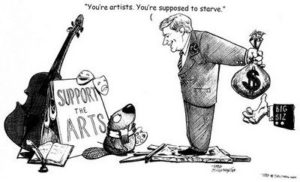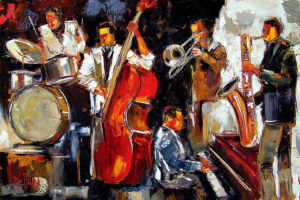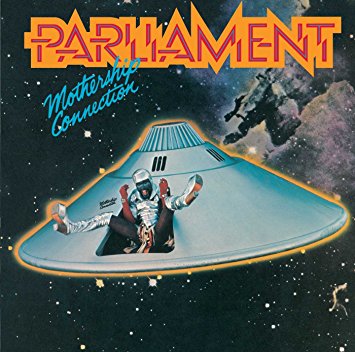After thinking about my previous blog posts, I realized that I unintentionally kept returning to art history. I alluded to Hopper’s and Motley’s paintings and the concept of the anchor (it’s also worth noting that art history came up in group conversation when I thought about tenebrism in Victor LaValle’s Big Machine art allusions). Looking back on this, my blog posts’ content itself aligns with a course concept: recursion. But in my thinking about this recursive process, I began to realize that this was no mere coincidence, rather, it highlights how interconnected recursion and memory actually are. Continue reading “Recursive Memory”
Fractals in Motion
In an older post of mine entitled “Everything Comes from the Fractal” I discussed the role of the fractal within African culture as well as the way, it applies to the controlling ideas and subjects featured in the literature we have read throughout the semester. In this post, I plan to expand upon this and demonstrate an example of one of the fractal thru-lines present in the last The Last Angel of History. This movie, while cheesy and dated gives a vivid example of a “fractal” that presents itself in music, art, and literature. Continue reading “Fractals in Motion”
Power In The Internet; An Artist’s Dilemma

Art is both extremely appreciated in the world and under appreciated; while there seems to be a public interest in art and what art can do for people, there is an obvious lack of interest in the funding of those who create—fortunately, there exist ways of leaping over that boundary today.
There two particular reasons for the difficulty pursuing a career in art and succeeding: there are a lot of people trying to pursue this career path and there are only a limited amount of opportunities for financial stability as an artist—though with things like the internet, artists are certainly gaining more chances to pursue art and succeed financially. Beyond the help of the internet, there has been one position that has helped musicians and artist pursue their desires for a fairly long time known as teaching.

The life of most musicians and artists today consists of a constant grind and combination of making connections, gigging or performing, and teaching—typically, the most stable part of this combination is teaching. The option to teach is a gift which enables musicians to support themselves financially as they try and pursue the creation of music or visual art, as well as the continuation of the music tradition—of course, there also exist those who want to teach the future generations the tradition of art.
Continue reading “Power In The Internet; An Artist’s Dilemma”
D.I.C.E.
Through the semester, many class discussions centered around ideas about the hardships minorities face in today’s society, as well as throughout history. But when faced with these issues, how does one react? How does our school provide the tools to encounter hate crimes and oppression? Continue reading “D.I.C.E.”
Inspirations
Writing my blog post about the connection between Vachel Lindsay’s poem The Congo: A Study of the Negro Race and Victor LaValle’s The Big Machine led me to think about the other inspirations behind the novel. Continue reading “Inspirations”
Art is Useless
I was recently reminded of a book I read in senior year of high school, The Picture of Dorian Gray by Oscar Wilde. I enjoyed the book, and I love Oscar Wilde, but the arguments Wilde made in the preface to the book were ones I couldn’t agree with. Wilde talks about how art is useless and should not have anything to do with the artist. Here are a few quotes that stood out to me:
“To reveal art and conceal the artist is art’s aim”
“No artist desires to prove anything.”
“All art is quite useless.”
Angels from the Congo
Throughout reading Victor LaValle’s The Big Machine, I had questions regarding the Devils of the Marsh, Solomon Clay, and how everything in the story tied together. Working in groups after finishing the book today, I found that a lot of us were still trying to piece together what it all meant. However, once our wheels started turning, connections kept coming and we ultimately found what we believe are the answers. Continue reading “Angels from the Congo”
Bloodchild and A Wrinkle in Time
Octavia Butler’s piece Bloodchild disarmed me when I first read it. The way that T’Gatoi would speak to the narrator was something that disturbed me, and the idea that the male narrator would end up carrying an egg for T’Gatoi, in a situation where the affirmative consent was unclear, frightened me deeply. What made the story more concrete in my head was the thesis that this story was not about slavery, but was drawing from an post-apacolyptic future where aliens landed on Earth and humanity had to negotiate with the aliens on Earth already. Bloodchild could be based in past events and conflicts, such as colonialism, but the vision is ultimately based in a future, a time far away from now.
Bloodchild is futuristic both in content and authorial vision, but throughout reading Bloodchild and Big Machine (which I have talked through in depth in the linked posts above), I have been thinking of the very first science fiction/fantasy novel that I read long ago. This novel is A Wrinkle in Time by Madeline L’Engle.
Dance, Dance, Dance
I am a dancer. Kind of. I mean I dance in my free time, and when nobody is watching. But, up until recently I wouldn’t have described myself as a dancer. I probably would have winced if I was called one and tried to deflect. But that slowly began to change recently. It all started with a class with Professor Mark Broomfield. We were told to wear comfortable clothes for the class, so I was already on edge on what the class would entail. When I first entered the classroom, I was a bit annoyed at the prospect of having to dance in public and the fact that I was not sure what type of dance we’d be doing only made me more concerned. By the time we finished the class however I felt comfortable in my own space and in my own movements and I felt like I had a lot to consider about myself. Continue reading “Dance, Dance, Dance”
Q: What Could Be Better Than Studying in the Watercolor Studio?
A: An Art department!
“Honest and earnest criticism from those whose interests are most nearly touched… this is the soul of democracy and the safeguard of modern society” ~ W.E.B. Du Bois, The Souls of Black Folk
Sitting at the paint-splattered tables in the room-formerly-known-as-the-watercolor-studio, I watch the sky darken through the enormous windows. It’s a good place to study, always quiet and full of a gentle, calming vibe (it must be something to do with those big windows, the paint on every surface, the vases full of plastic flowers balancing on the edge of the sink, the half-finished canvases lounging on the shelves) but I find its emptiness occasionally unnerving. The halls of the North Side of Brodie feel almost eerie sometimes; sure, people pass through on their way to and fro dance studios and the theater and Art History offices and the very occasional fine arts course but generally the halls are as empty as the walls (and the walls are very empty). As I ponder the emptiness of the space, I feel an old frustration bubble up. The parts of the campus that formerly housed the Art department seem to scream of an “If only…”
Continue reading “Q: What Could Be Better Than Studying in the Watercolor Studio?”

